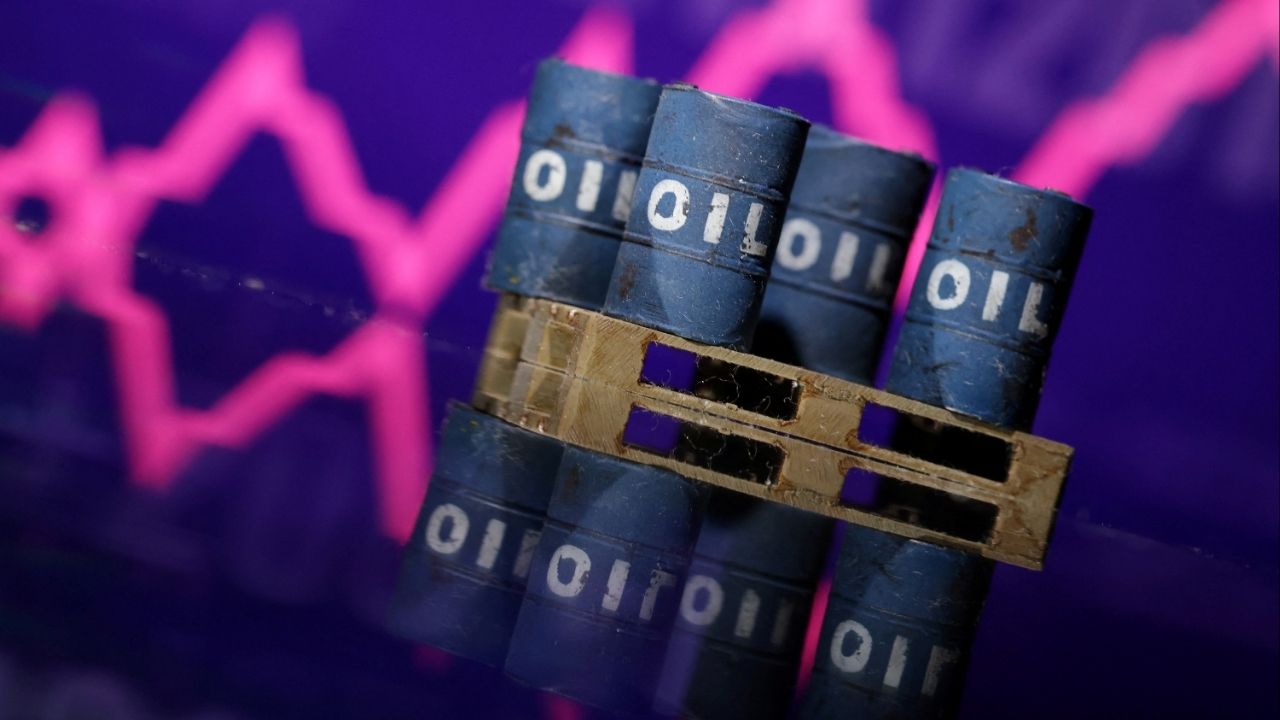Miniatures of oil barrels and a rising stock graph are seen in this illustration taken January 15, 2024. (Reuters/File)
Share
|
Getting your Trinity Audio player ready...
|
(Reuters) – World stock markets tumbled on Friday and oil prices surged as Israel launched military strikes on Iran, sparking a rush into safe havens such as gold and the dollar.
An escalation in the Middle East – a major oil-producing region – adds uncertainty to financial markets at a time of heightened pressure on the global economy from U.S. President Donald Trump’s aggressive and erratic trade policies.
Early on Friday Trump urged Iran to make a deal over its nuclear program, saying that there was still time for the country to prevent further conflict with Israel.
Market reaction, which had abated in early European trade, gathered a renewed momentum as the session wore on.
Brent crude oil prices were last up almost 7% at $74.2 per barrel, having jumped as much as 14% during Asian hours. They were set for their biggest one-day jump since 2022, when energy costs spiked after Russia’s invasion of Ukraine. U.S. oil futures rose 7.3% to around $73.
Gold, a classic safe-haven at times of global uncertainty, rose 1.8% to $3,445 per ounce, bringing it close to the record high of $3,500.05 from April.
The rush to safety was matched by a dash out of risk assets. The Dow Jones Industrial Average fell 1.17%, the S&P 500 dropped 0.66%, and the Nasdaq Composite lost 0.78%. European shares dropped almost 1% and in Asia, major bourses in Japan, South Korea and Hong Kong fell over 1% each.
“Clearly the big question is how far does this go?,” said Chris Scicluna, head of economic research at Daiwa Capital Markets in London, referring to the Middle East tension. “The market has got it right in terms of stocks down, oil and gold up.”
Israel said it had struck Iran‘s nuclear facilities and missile factories and killed a swathe of military commanders in what could be a prolonged operation to prevent Tehran building an atomic weapon.
Trump suggested that Iran had brought the attack on itself by resisting U.S. demands in talks to restrict its nuclear program, and urged it to make a deal, “with the next already planned attacks being even more brutal”.
Washington said it had no part in the operation, however.
The developments mean another major geopolitical tail risk has now become a reality at a time when investors are wrestling with major shifts in U.S. economic and trade policies.
“The geopolitical escalation adds another layer of uncertainty to already fragile sentiment,” said Charu Chanana, chief investment strategist at Saxo, adding that crude oil and safe-haven assets will remain on an upward trajectory if tensions continue to intensify.
The Israeli shekel fell almost 1.8% and long-dated dollar bonds for Israel, Egypt and Pakistan slipped.
Two-Way Pull for Bonds
U.S. Treasuries initially benefited from the rush for safer assets, but as the day wore on focus turned to the inflationary impact of higher oil prices.
U.S. 10-year Treasury yields were last up 3 basis points (bps) at 4.38%, having touched a one-month low of 4.31%. Bond yields move inversely to prices.
“This is a flight-to-safety event. But markets are struggling a bit and in the fixed income space you have an oil-price shock that is inflationary and so you should see markets expecting an even more hawkish Fed,” said James Rossiter, head of global macro strategy at TD Securities.
“On the other hand you have the flight-to-safety, which should push bond yields lower.”
Germany’s 10-year bond yield touched its lowest level since early March at around 2.42%, before also inching higher.
Some traders were attracted to the dollar as a haven, with the dollar index up 0.86% to 98.51, retracing most of Thursday’s sizeable decline.
The Swiss franc briefly touched its strongest level against the dollar since April 21, before trading 0.43% lower at around 0.814 per dollar.
Fellow safe haven the Japanese yen fell 0.65% to 144.44 per dollar, giving up earlier gains of 0.3%.
The euro was down 0.7% at $1.15, after rising on Thursday to the highest since October 2021.
—
(Reporting by Lawrence Delevingne in Boston and Dhara Ranasinghe in London; additional reporting by Kevin Buckland in Tokyo; Editing by Toby Chopra)




















